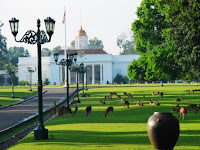Many people travelling to Indonesia enter through the capital, Jakarta, which immediately challenges visitors to move on find the next location check out. Of course different people choose different destinations based on the type of journey they are on, but the difficulty of where to head next remains the same. Some jump on the first train out of Jakarta and head to Yogyakarta before flying to Bali. Some go straight to Bandung to start their volcano-searching expedition across Java. And many others head straight to Bogor where they can get some much needed respite from the heat, smog and traffic which for many puts a dampener on their Jakarta experience. This last option is a great choice.
Bogor is located 90 kilometres and 1.5 hours north of Jakarta at an elevation of between 200 and 300 metres above sea level. It’s a much more relaxed place than Jakarta and it’s primarily due to the way the city was constructed with an enormous botanical garden at its core. This garden is the largest tourist attraction in town, but there are other things to do while you’re Bogor. Here’s a wrap on the key highlights.
Bogor Botanical Gardens
 |
| Indonesia Presiden Palace at Bogor |
The Bogor Botanical Gardens are massive. Measuring roughly a kilometre by a kilometre and covering an area of 80 hectares, the gardens can be an all-day adventure if you love gardens or simply a two-hour brisk walk if you’re just out to get some fresh air and have a brief look. The gardens are filled with a massive variety of plants from all over Indonesia, plenty of fountains, a nifty zoology museum and a great cafe which overlooks the stunning grounds. The gardens are a fantastic contrast to the hustle and bustle of Jakarta and reason alone to visit Bogor.
Gong Pancasan
 |
| Gong pancasan bogor |
About a kilometre southwest of the botanical gardens past the Bogor Trade Centre on Jalan Pancasan is a little gong factory, which has been making gongs in this very spot for the past two centuries. Wiry men pound gongs into shape next to an open fire pit in conditions that would be illegal in many Western countries. The men earn little for their daily toil and graciously accept small donations from the trickle of tourists who come to observe this old tradition. The shop next door has a small selection of items for sale. While this is an interesting activity, it doesn’t require much of your time. Allow an hour including the walk to and from the gardens.
Gunung Gede Pangrango
 |
| Gunung gede Pangrango |
The Cibodas gardens are right next to the main entrance to Gede Pangrango National Park, the highlight of which is the climb to the 2958m peak of the volcanically active Gunung Gede. From the top of Gede on a clear day you can see Jakarta and the south coast of Java.
Because it's close to Jakarta, this is an extremely popular mountain to climb. Numbers are restricted and during peak holiday season there may be a waiting list. At other times you can normally just rock up and trek the next day.
On arrival, register for the climb and obtain your permit (a steep Rp.50,000/$4 for foreigners) from the PHKA office just outside the entrance to the gardens. The office has an information centre and pamphlets on the park, which is noted for its alpine forest and bird life, including the rare Javan eagle. Officially, guides to the summit have to be hired here for Rp.350,000 / $30 for a two-day round trip, though the main trail is easy to follow. Gunung Gede is closed to hikers between January and March, usually August too, and during stormy weather.
From Cibodas, the trail passes Telaga Biru (15 minutes), which is a blue-green lake. Cibeureum Falls (one hour away) lie just off the main trail. Most picnickers only go this far, though some continue on to the hot springs, 2½ hours from the gate. The trail continues to climb another 1½ hours to Kandang Badak, where a hut has been built on the saddle between the peaks of Gunung Gede and Gunung Pangrango (3019m). Take the trail to the right for a hard three-hour climb to Pangrango. Most hikers turn left for the easier, but still steep, 1½-hour climb to Gede, which has more spectacular views. The Gede Crater lies below the summit, and you can continue on to the Suryakencana Meadow.
The 10km hike right to the top of Gunung Gede takes at least 10 hours there and back, so you should start as early as possible and take warm clothes (night temperatures can drop to 5°C), food, water and a torch (flashlight). Most hikers leave by 2am to reach the summit in the early morning before the mists roll in.















0 comments:
Post a Comment